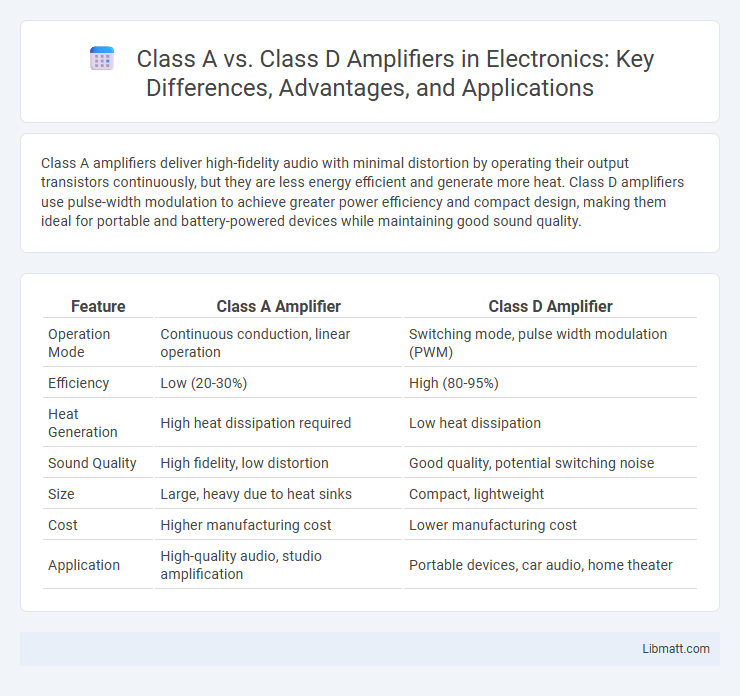Class A amplifiers deliver high-fidelity audio with minimal distortion by operating their output transistors continuously, but they are less energy efficient and generate more heat. Class D amplifiers use pulse-width modulation to achieve greater power efficiency and compact design, making them ideal for portable and battery-powered devices while maintaining good sound quality.
Table of Comparison
| Feature | Class A Amplifier | Class D Amplifier |
|---|---|---|
| Operation Mode | Continuous conduction, linear operation | Switching mode, pulse width modulation (PWM) |
| Efficiency | Low (20-30%) | High (80-95%) |
| Heat Generation | High heat dissipation required | Low heat dissipation |
| Sound Quality | High fidelity, low distortion | Good quality, potential switching noise |
| Size | Large, heavy due to heat sinks | Compact, lightweight |
| Cost | Higher manufacturing cost | Lower manufacturing cost |
| Application | High-quality audio, studio amplification | Portable devices, car audio, home theater |
Introduction to Audio Amplifiers
Class A amplifiers provide high fidelity audio by operating their output transistors continuously, minimizing distortion but generating significant heat and lower efficiency. Class D amplifiers use pulse-width modulation to switch output devices rapidly on and off, achieving high power efficiency and compact design ideal for portable and high-power applications. Understanding these fundamental differences helps in selecting the appropriate amplifier type for specific audio performance and energy consumption needs.
What is a Class A Amplifier?
A Class A amplifier operates by conducting current throughout the entire input signal cycle, ensuring minimal distortion and high linearity at the cost of lower efficiency, typically around 20-30%. It uses a single transistor or tube biased to remain in the active region, resulting in continuous power dissipation of heat. These amplifiers are favored in high-fidelity audio applications where sound quality and accuracy are prioritized over power consumption.
What is a Class D Amplifier?
A Class D amplifier is a highly efficient type of audio amplifier that uses pulse-width modulation (PWM) to convert the input signal into a series of high-frequency pulses. Unlike Class A amplifiers, which operate with continuous current flow leading to higher heat dissipation, Class D amplifiers switch transistors on and off rapidly, minimizing power loss and enabling compact designs. This switching mechanism allows Class D amplifiers to achieve efficiencies above 90%, making them ideal for battery-powered and portable audio applications.
Core Differences: Class A vs. Class D
Class A amplifiers operate by continuously conducting current through the output transistors, resulting in high linearity and low distortion but lower efficiency, typically around 20-30%. Class D amplifiers use pulse-width modulation to switch output transistors fully on or off, achieving efficiencies of 80-90% or higher while generating less heat. Your choice depends on whether audio fidelity (Class A) or power efficiency and compact design (Class D) is the priority.
Efficiency Comparison
Class D amplifiers offer significantly higher efficiency than Class A amplifiers, often exceeding 90%, by utilizing pulse-width modulation to minimize power loss. Class A amplifiers typically run around 20-30% efficiency because their output transistors conduct continuously, generating more heat. If your priority is energy conservation and cooler operation, Class D amplifiers provide a clear advantage in efficiency for audio applications.
Sound Quality and Distortion Analysis
Class A amplifiers produce superior sound quality due to their continuous current flow, resulting in low distortion and high fidelity audio reproduction. Class D amplifiers, while more efficient and compact, introduce higher distortion levels primarily from switching noise, which can affect audio clarity despite advancements in filtering techniques. Sound quality in Class A remains more linear and warm, whereas Class D offers practical benefits but requires careful design to minimize distortion artifacts.
Power Consumption and Heat Management
Class A amplifiers consume continuous power regardless of audio output, leading to significant heat generation that requires robust heat sinks or cooling systems. In contrast, Class D amplifiers operate with high efficiency, converting most power into audio output and producing minimal heat, which reduces the need for extensive heat management. This efficiency difference makes Class D amplifiers preferable for applications demanding lower power consumption and compact thermal design.
Size and Design Considerations
Class A amplifiers typically feature larger, heavier components and require substantial heat sinks due to continuous high power dissipation, resulting in a bulkier design. Class D amplifiers use smaller, more compact components with efficient switching technology that minimizes heat generation and allows for a more lightweight, space-saving design. These size and thermal management differences make Class D amplifiers ideal for portable or space-constrained applications, while Class A amplifiers remain favored for their simplicity and audio quality in larger setups.
Applications: Where Each Class Excels
Class A amplifiers excel in high-fidelity audio applications such as audiophile-grade sound systems and recording studios due to their low distortion and superior linearity. Class D amplifiers are ideal for portable devices, car audio systems, and subwoofers because of their high efficiency, compact size, and reduced heat generation. Your choice depends on whether sound quality or power efficiency is the priority in your specific application.
Choosing the Right Amplifier for Your Needs
Class A amplifiers deliver high-fidelity audio with low distortion, making them ideal for audiophiles prioritizing sound quality, while Class D amplifiers offer superior energy efficiency and compact design suited for portable or power-sensitive applications. Your choice depends on the importance of audio purity versus power consumption, with Class A favoring warm, clean sound and Class D excelling in performance and size. Evaluating your specific use case, such as home audio systems or mobile devices, will guide you to select the amplifier that best meets your sound and efficiency requirements.
Class A vs Class D Amplifier Infographic

 libmatt.com
libmatt.com